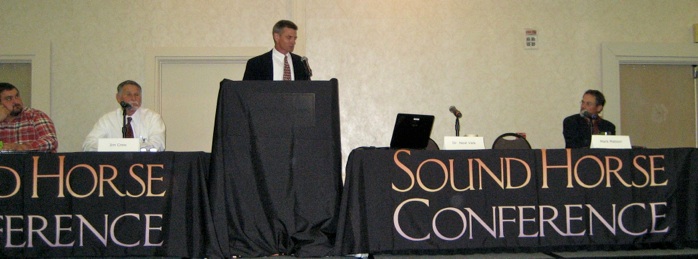While in Tennessee recently, I had the opportunity to spend a few minutes with Dr. Neal Valk, a board-certified veterinary surgeon, friend, and fellow clinician in Liberated Horsemaship’s hoof trimming training program. I’ve known Neal for six years now, and continue to respect and appreciate his contributions to my knowledge base when it comes to a veterinarian’s perspective on hoof care, which is his specialty. In fact, he is the only veterinarian I’ve met to date in whom I have complete confidence when it comes to matters of the hoof, and, should a horse of mine ever require hoof surgery, Neal would be the first person I’d talk to. And that’s why I refer to him as “The Vet” – because Neal’s made it his mission to go way beyond the boundaries of his veterinary education and undertake an in-depth study of the equine digit.
I asked Neal if we could do a very quick interview, because although I’ve now heard him express his opinion on these matters many times, I thought it would be more appropriate for my readers to hear it “from the horse’s mouth,” so to speak. So here are a couple of quick questions I put to “The Vet” –
Steve: As a board-certified surgeon, you’ve had training far and above what “normal” veterinarians have had. I’m curious: could you describe your education, specifically about the equine foot, and what you’re taught about the equine foot in vet school?
Dr. Valk: In veterinary school, beginning in the very first year while studying basic equine anatomy, we learn a lot about the anatomy of the foot, internal and external. We learn about the physiology of the foot – the nerve supply – and that’s pretty much it. As we proceed in veterinary school, we take courses in pathology, where we learn to recognize pathology at a microscopic level. And when we take courses in radiology, we’re taught normal radiology of the equine foot, and then we’re taught what abnormal looks like; we’re taught what pathology looks like on radiographs. As we proceed further into species-specific classes – musculoskeletal, for example, is the course where we learn about lameness and everything that has to do with the musculoskeletal system in the horse – we again touch on anatomy and speak more specifically about pathology as it pertains to the live animal, and do a bit of work with learning how to test – how to diagnose – pathology. It’s very pathology-oriented. And in the final year, in clinics, we actually see the horse’s feet, and do some hands-on work: hoof testers – that sort of thing. We do some nerve blocks; again, diagnostic procedures to try to identify pathology, which, in most cases, ultimately leads to radiographs, looking for more pathology.
Steve: So you don’t really receive a lot of formal education about what “normal” looks like in a foot, with respect to trimming or the form of the foot?
Dr. Valk: No. At least when I went to veterinary school, there was no mention at all of hoof maintenance or trimming or anything like that. At the clinical level, the final year on our clinical rotations, we talked about “corrective shoeing” for, again, pathology or certain pathologies. But no, we didn’t have any instruction on hoof maintenance or that sort of thing – not with horses. I remember having that with cattle, ironically, but not so much with horses. I certainly wouldn’t say that we worked with any normal feet. Pretty much everything that came through the clinic was abnormal for one reason or another; at least, that is, based on my view now. But I don’t remember having any kind of formal instruction in farriery. It was basically, well, “this is the pathology, that means this is the diagnosis, this is the disease, and ask the farrier to do this,” and that’s kind of the way we handled it.
Steve: Sort of a “cookbook.”
Dr. Valk: Yeah. Really no hands-on, as far as the horse’s feet went.
Steve: And these days, as a practicing veterinarian and as a practicing natural hoof care provider, are there circumstances where you recommend, you know, “this is pathology, and you’ve got to put a shoe on it”? Contracted tendons or laminitis or navicular disease? Broken bones? Anything like that where you feel that a shoe is the only or the best course of action for that animal?
Dr. Valk: I think the only situation where I could justify the use of a rigid, metal, semi-permanently-fixed shoe would be sliding plates on the hind feet of a reining horse. Strictly to reduce the traction of the bare foot, because horses can’t slide when they’re barefoot – they have too much traction. But as far as dealing with any kind of pathology or any kind of abnormal hoof condition, I no longer see a reason or a use for shoes. I used to think that a continuous rim shoe or an egg-bar shoe on a pad was necessary to treat coffin-bone fractures, but I’ve had the experience – at least one time – of treating a coffin-bone fracture with nothing. Just time and a barefoot, natural trim. I did put the horse in a stall for a couple of months, but it healed beautifully with nothing on the foot. So no, I made a big turnaround from the vet I used to be years ago, and I can’t justify using steel on feet. I just can’t do it. There are too many alternatives – too many better options, I think. I use a lot of hoof boots and pads and that sort of thing to rehabilitate horses, treat foundered horses, and I don’t have any of the side effects or the negative aspects of fixed shoeing that I used to have to deal with. So I’ve gotten completely away from using shoes of any kind.
Steve: Do you actually consider there being some benefits to shoes that are more than offset by the problems they create, or is it more of a “you just don’t need them – period” kind of thing?
Dr. Valk: I think there are benefits to using shoes in some scenarios, but not necessarily related to the foot or problems of the hoof. I think there are some situations where, for whatever reason, it’s inconvenient or it’s impractical for an owner to manage a barefoot horse. And in that case, I would rather see the horse be comfortable in shoes than be uncomfortable for lack of attention on the part of the owner. And, again, I don’t think that’s the best way to go, but this is the real world and that’s just the way it’s going to be some times. If you have an owner that’s not willing to put hoof boots on a horse that needs them when they’re riding or whatever, putting a shoe on is a fallback position. I wouldn’t do it personally, but I can see that there are situations where that’s necessary.
Steve: Given the best shoeing job possible – everything is as perfect as you can imagine it, based on what you know, do you see the shoe as a neutral thing in that case, or as a negative thing?
Dr. Valk: I think if you’re talking about a rigid metal shoe, then I cannot see that there’s any benefit, even in a perfect situation or an ideal situation. I think maybe my opinion would change If I had more experience with plastic shoes or some other type of polymer shoe that actually flexes and bends and functions more like the barefoot hoof does. I’d be interested to find out about things like that. But I really don’t think there’s a good justification to use rigid, fixed shoes on a horse. But I do want to add that I certainly have friends who shoe their horses, and I don’t have a problem with that. Ultimately, it’s their decision.
You can read more about Dr. Valk’s background and philosophy on his Natural Equine Podiatry website. He currently teaches a seminar through Liberated Horsemanship entitled “Natural Hoof Care and Veterinary Medicine Working Together Toward a Common Goal“. It’s highly informative and well worth attending.
Thanks, Neal!

